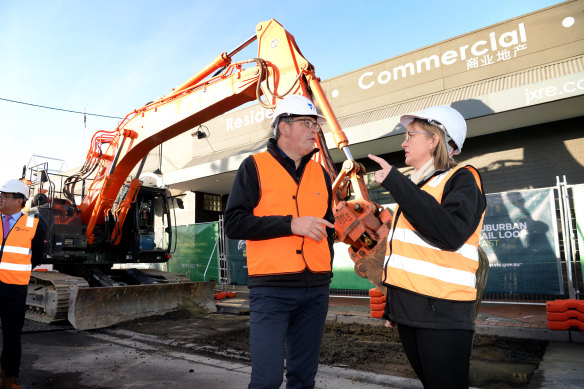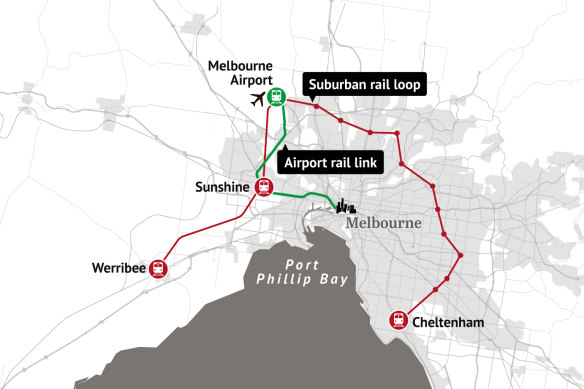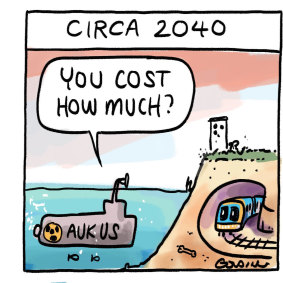Transport and planning experts have warned that the Suburban Rail Loop no longer offers taxpayers value for money and urged the government to follow the opposition’s pledge to shelve the project after an independent analysis found the first two stages were expected to cost $125 billion – more than double Labor’s initial estimate for the entire project.
But Premier Daniel Andrews maintains it will cost more to mothball the project than press on, pointing out that Victorians voted for the rail loop after it was proposed ahead of the 2018 election.

Premier Daniel Andrews and Jacinta Allan, now his deputy, inspect works on the Suburban Rail Loop station in Clayton this year.Credit: Andrew Henshaw
The state’s parliamentary budget office published a report that showed the north and east sections of the rail loop could blow out to more than $125 billion before their completion in 2053. When the government announced the project in the months before the 2018 election, Transport Infrastructure Minister Jacinta Allan said the cost of the entire rail loop from Cheltenham to Werribee would be up to $50 billion.
Grattan Institute Transport and Cities Program director Marion Terrill said the independent analysis brought into further question the merits and value of the railway line.
“Victoria is facing a mountain of debt and it’s growing and this is a time when it’s expensive to get labour and material,” Terrill said.
“A year ago, the government told us the benefit-to-cost ratio was 1.1 to 1.7 [meaning for every $1 spent on the project, between $1.10 and $1.70 would be returned] and that’s if everything was going well. One point one is already a very skinny margin … A year later, we find out the cost is estimated to be orders of magnitude larger. It’s difficult to believe that this actually offers net benefits to the community now.
“This is the time to pause the project and let the dust settle.”
The project’s business and investment case, released last year, shows the first two stages of the project will cost between $30.7 billion to $50.5 billion. The government has begun work on the first stage, running from Cheltenham to Box Hill, which the business case stated would cost between $30 billion to $34 billion.
But the forecasts in the parliamentary budget office report, requested by the opposition, eclipse those numbers without even accounting for the final stage of the loop, which would link Werribee and Melbourne Airport. However, the report found the first stage, due to be completed in 2035, would cost about $36.5 billion.
“One sure way to make sure that the Suburban Rail Loop will cost more is to scrap it, delay it, shelve it,” Andrews said on Thursday.

The Andrews government’s planned Suburban Rail Loop.Credit:
“Our suburbs need the suburban route, and that’s what we’re getting on delivering … it’s a big project, it takes time, it’s what Victorians voted for. And you have to do road and rail, hospitals and schools, nurses and teachers, you have to do skills and jobs.
“You’ve got to do all those things and more and that’s exactly what we are doing, and it’s what we’ll continue to do, and it’s what we will offer.”
Opposition leader Matthew Guy this week vowed to shelve the Suburban Rail Loop and invest the money into the healthcare system, declaring Victorians had a choice between the government’s “rail tunnel or me fixing the health service”.
So far, the state has allocated $11 billion to build the first stage of the project and spent $2.2 billion on early works contracts, which the opposition will not tear up, leaving the Coalition with about $8.8 billion to redirect to the healthcare system.
The government has said the first stage would be funded by one-third state government contribution, one-third federal government contribution and one-third by value capture, meaning taxpayers will not be slugged $34 billion. However, the federal government has so far only committed $2 billion.
Michael Buxton, professor of environment and planning at RMIT, said he believed the cost of building the first two stages of the rail loop would exceed $200 billion, given the project was not expected to be completed for another 30 years.
Early planning works have begun on the second stage of the project from Box Hill to Melbourne Airport. The third and final stage of the project is subject to further investigation, planning and development.
“We have to ask ‘where is the value for money from such a huge amount of money that doesn’t really connect people?’” Buxton said.
“If you have a look at Cheltenham from Clayton in the first stage, that’s eight kilometres between stations, leaving 200,000 people between that route who won’t be well-connected to the stations. This is a line that’s connecting a very limited number of major centres ... but it’s not going to be a benefit for people along the route.”
RMIT urban policy professor Jago Dodson said the government must release a metropolitan planning strategy to lay out how the city was expected to change and how governments planned to respond to those challenges.

Credit: Matt Golding
He said the public had never been given the opportunity to compare the Suburban Rail Loop to other transport projects that may offer greater benefits for city.
“It looks almost like a complete failure in metropolitan planning that a project of this financial magnitude could be decided to proceed with almost no [wider strategic] planning whatsoever,” Dodson said.
Opposition transport infrastructure spokesman Matthew Bach said the costing from the parliamentary budget office revealed the Suburban Rail Loop did not stack up and was “a dog of a project”.
“The apparent benefits of this project ... are simply not there when you consider the astronomical cost,” Bach said.
The Morning Edition newsletter is our guide to the day’s most important and interesting stories, analysis and insights. Sign up here.